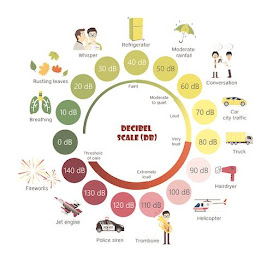Indoor Environmental Quality: Acoustics + Indoor Air
Weekly Summary
While these topics have been mentioned throughout the course of our book, this week the chapter was completely dedicated to the Indoor Environment which encompasses both Acoustical Control and the Indoor Air Quality. As Interior Designers we can be intentional about both of these things in the way we design and the products we choose.
Acoustics is the general term for how sound travels and is heard; noise is considered unwanted sound. Sound is measured in decibels and the max. limit of human comfort is about 110-120, but really, the healthy amount of average surrounding sound should be below a "loud" volume of 70 decibels. Sound can be reflected, absorbed, or transmitted, and controlling these effects is possible through design efforts. When designing a space some common terminologies are the Noise Reduction Coefficient (NRC), Sound Transmission Coefficient (STC), Transmission Loss (TL), and Reverberation Time (RT). Various materials are rated according to some of these variables which typically indicates their absorption capacity. Various absorbing materials include carpeting, acoustical ceiling tiles, and various textiles; sustainable ceiling design options are acoustical clouds or canopies.When it comes to sound, the spatial volume of a room is an important consideration. For rooms with a low desired amount of Reverberation time, designers keep the spatial volume smaller. In contrast, for room such as performance halls, lecture spaces, etc., where a higher reverberation time may be desirable, a larger spatial volume is utilized.
Creating privacy and private area in a larger space is key, especially in commercial office design. HIPAA now also requires that personal medical information be protected, so dividers and or separate check-in rooms is necessary in healthcare design. Privacy is not only defined by walls or physical separators but also acoustical control. Acoustical partitions are best for commercial workstation design, and acoustical insulation may be necessary in other areas as well. There are a list of recommended heights and specific positioning recommendations for partitions that will maximize acoustical control.
In addition, to the importance of spatial acoustics, the Indoor Air Quality is extremely important as it not only affects productivity and overall environment, but it also has physical effects on people. Poor Air Quality is all too common, and can cause illnesses such as Sick Building Syndrome (SBS), Building Related Illness (BRI), or Legionnaire's Disease. Symptoms may include: irritation of eyes and throat, dizziness, fatigue, or asthma. The best treatment is to eliminate the source of contamination which may be mold, radon, cigarette smoke, VOCs, or all of the above. Improved ventilation and the use of air cleaners/ purifiers will also improve the indoor air quality.
As designers of the human experience, it is unbelievable valuable to carefully consider acoustical control and indoor air quality, both of which impact the entire environment and the overall user experience.
Indoor Air Quality: COVID-19 Research
With indoor Air Quality already being a general concern, COVID-19 as a highly contagious disease was by no means a helpful addition to the problem. Though the spread of COVID is still somewhat unknown, like all illnesses it came with germs. The pandemic introduced a widespread disease into the air in addition to already existing pollutants. It also harmed indoor air quality, in that, everyone began to stay inside, concentrated in their homes -- living, cooking, working, and filling their spare time with a multitude of hobbies. I can imagine that the increase in VOC's and concentrated activity indoors did not necessarily improve the indoor air quality. Mask wearing was another problem in the sense that people were not receiving the same amount of air flow; and germs and other particles were concentrated on masks that people were constantly breathing through.However, we must also consider that COVID enforced strict measures of isolation and health safety to the point of also hopefully increasing indoor air quality. Since protecting people's lungs and immune systems was extremely important during the onset of COVID, there was an increased awareness in overall healthy habits and environments. People were encouraged to spend time outside because that was often safer than being in concentrated areas with other people. Large crowds, or crowds in any sense, were eliminated for a period of time; and increased ventilation was encouraged.
The following sources were helpful guides; click the links below for more technical information on Covid-19 and indoor air quality:
Indoor Air and Coronavirus (COVID-19) | US EPA
Indoor air quality improvement in COVID-19 pandemic: Review - PMC (nih.gov)








Delia,
ReplyDeleteI really enjoyed your weekly summary on the importance of acoustical control and indoor air quality in interior design. Your deeper look into the impact of spatial acoustics and the need for privacy in commercial office design, as well as the important role of indoor air quality, were incredibly valuable and very informative. When reading your assessment on COVID-19 and indoor air quality I was really intrigued by the correlations you made between SBS and indoor air systems. Your post was very informative and got me thinking about new ways we can enhance the overall experience in healthier ways in different spaces. Nice job!
Delia,
ReplyDeleteI really liked your detail on your blogs and your description on indoor air quality and acoustical design and different ways that it plays a factor in an interior space. I also really liked the different vocabulary used such as "Noise Reduction Coefficient (NRC), Sound Transmission Coefficient (STC), Transmission Loss (TL), and Reverberation Time (RT)." It is really important to identify these as an interior design. Lastly, I really liked your research on how indoor air quality and SBS was impacted from the Covid-19 pandemic. It is crazy the transitions we had to go through and that it was like three years ago!
Delia,
ReplyDeleteI enjoyed reading your detail description of the importance of considering Acoustics and Indoor Air
Quality as an Interior Designer. Being intentional about these considerations is vital to the health and wellness of humans. Your description of sound and what "noise" is was excellent. You also listed various sound absorbing materials that can reduce "noise". I appreciated how you summarized HIPPA standards and how medical information must be protected. As designers, we will need to create privacy in healthcare by using walls or separation as well as noise reduction.
Your image of indoor pollutants was helpful. I also appreciated the sources and information you provided for looking at the effects of Covid. 50/50 points
Delia,
ReplyDeleteI appreciated how you started off your blog by explaining the importance of indoor environmental quality and interior design. You did a great job explaining the importance of noise control in work spaces and how the size of the room can affect the needed noise control. I liked your research you did on how covid has affected air quality. It was crazy to me how the masks and staying in our homes have affected our air quality for the worse.
Delia,
ReplyDeleteYou did a good job with organizing your summary! I really liked ow you included a detailed description of the indoor environmental quality. I also thought it a strong point in your blog was when you discussed noise control and how the size of the room or space largely effects the travel of noise. I also thought your research on how the COVID-19 pandemic effected our air quality was very thorough and informative. Good job, Delia!